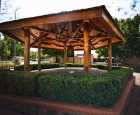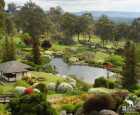At the end of World War II, many Japanese troops became captives with the allies' victories in the Pacific Ocean, when the allies had a large prison camp in Australia called Koran (Cowra), 320km west of Sydney. It's a small town in inland New South Wales.
The Cowland POW camp held nearly 20,000 prisoners of war, divided into four ABCD districts, including axis Italy, Germany, and Japan surrendered prisoners of war. Zone B holds Japanese prisoners of war, mostly from Japan's failed navy in the Pacific.

At its peak, the number of Japanese prisoners of war reached 1104 members, because the allies' personnel complied with the Geneva Conventions, and they did not abuse prisoners of war like the Japanese army, but instead gave Japanese prisoners of war the right amount of labour, mainly to cut down trees. Loose soil, cultivation and other physical work, when the wind also let them free movement, but also baseball, sumo, mahjong and other recreational food and even fish.

But because of the differences in language and the hatred of war, the relationship between the two sides was still tense, and the relations between the guards and the prisoners of war were very cold.
In early August 1944, because of the increasing number of prisoners of war, the allies considered moving Japanese soldiers other than Japanese non-commissioned officers to new captivity camps 400 miles away, a news that Japanese prisoners of war had learned.
Japanese soldiers have a strong sense of encirclement, and they have become closer to each other in the POW camps. After their analysis, they believe that the Allied forces intended to separate their officers and soldiers and prepare them to accept worse treatment. So, faced with the fear of separation, they defeated the fear of machine guns, and a prison escape was planned and carried out by all 1104 people.
On August 5, 1944, at 2 a.m., the jailbreak was officially launched.
Led by leader Fondo, more than a thousand Japanese troops rushed out of their cells with knives and spoons, shouting "Viva the Emperor." their weapons were knives, spoons, baseball bats with nails, all prepared in advance. Premeditated they scared the guards on the spot.
Two gun-rigging guards were killed on the spot by Japanese prisoners of war with a variety of strange weapons, fortunately, the guards desperately pulled the bolt of the machine gun before they died, making it impossible for the Japanese to use the machine gun to carry out the attack. The Japanese prisoners of war, completely by their will, withstood machine gun fire with their flesh, desperately pulled down the barbed wire, and fled in droves.
Statistics later showed that 1104 Japanese troops had escaped, most of whom had been returned to arrest by Australia's army, and that some Japanese troops had committed suicide on their way to escape, the largest escape by Japanese troops during World War II.
Australians still have a deep memory of this history. In 1984, the real history was put on screen, and the film, "The Cowra Breakout", scored 8.1 on IMDB; In addition, the Kaolan Japanese Garden and Cultural Center (Cowra Japanese Garden and Cultural Centre), built in 1979, commemorates this period of history, with carefully trimmed garden vegetation, two lakes, and the Edo bungalow in a quiet and peaceful atmosphere. The bloody rain of August 5, 1944 is a reminder of peace's hard-won, beautiful things that need to be cared for and cherished.

